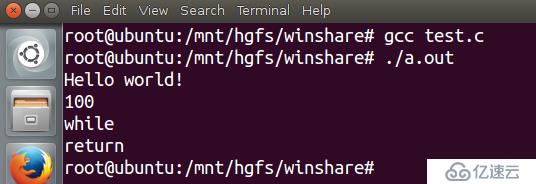您好,登錄后才能下訂單哦!
您好,登錄后才能下訂單哦!
在 C 語言中還有 # 和 ## 這種操作符的存在,只是不經常見,那么我們今天就來講下它們的用法。
A、 # 運算符用于在預處理期將宏參數轉換為字符串,它的轉換作用是在預處理期完成的,因此只在宏定義中有效。編譯器不知道 # 的轉換作用,用法:#define STRING(x) #x。下來我們以代碼為例進行分析,代碼如下
#include <stdio.h>
#define STRING(x) #x
int main()
{
printf("%s\n", STRING(Hello world!));
printf("%s\n", STRING(100));
printf("%s\n", STRING(while));
printf("%s\n", STRING(return));
return 0;
}我們看到第 7-10 行想要打印字符串,那么我們這樣定義可以嗎?我們編譯下看看結果

我們看到已經打印出了字符串。那么我們來單步編譯下,看看經過預處理器處理過的文件變成什么樣了,生成的代碼如下,還是注釋掉頭文件
test.i 代碼
# 1 "test.c"
# 1 "<built-in>"
# 1 "<command-line>"
# 1 "/usr/include/stdc-predef.h" 1 3 4
# 1 "<command-line>" 2
# 1 "test.c"
int main()
{
printf("%s\n", "Hello world!");
printf("%s\n", "100");
printf("%s\n", "while");
printf("%s\n", "return");
return 0;
}我們看到宏定義里面的字符已經變成相應的字符串了,證明我們那樣定義還是靠譜的。下來我們再來看看一個示例代碼,看看 # 運算符的妙用,代碼如下
#include <stdio.h>
#define CALL(f, p) (printf("Call function %s\n", #f), f(p))
int square(int n)
{
return n * n;
}
int func(int x)
{
return x;
}
int main()
{
int result = 0;
result = CALL(square, 4);
printf("result = %d\n", result);
result = CALL(func, 10);
printf("result = %d\n", result);
return 0;
}我們在這個代碼中想要打印出它調用的函數名,但是函數名是我們隨機指定的。這樣的功能是 C 語言寫的函數實現不出來的,那么我們看看 # 運算符能夠實現這樣的功能嗎?編譯看看結果

結果已經很明顯了。我們再來看看經過單步編譯后的文件
test.i 代碼
# 1 "test.c"
# 1 "<built-in>"
# 1 "<command-line>"
# 1 "/usr/include/stdc-predef.h" 1 3 4
# 1 "<command-line>" 2
# 1 "test.c"
int square(int n)
{
return n * n;
}
int func(int x)
{
return x;
}
int main()
{
int result = 0;
result = (printf("Call function %s\n", "square"), square(4));
printf("result = %d\n", result);
result = (printf("Call function %s\n", "func"), func(10));
printf("result = %d\n", result);
return 0;
}我們可以看出確實如我們所想的那樣。
B、 ## 運算符用于在預處理期粘連兩個標識符,它的作用是在預處理期完成的,因此只在宏定義中有效;編譯器不知道 ## 的連接作用,用法:#define CONNET(a, b) a##b。下面我們還是以代碼進行說明,代碼如下
#include <stdio.h>
#define NAME(n) name##n
int main()
{
int NAME(1); // name1
int NAME(2); // name2
NAME(1) = 1; // name1 = 1
NAME(2) = 2; // name2 = 2
printf("NAME(1) = %d\n", NAME(1));
printf("NAME(2) = %d\n", NAME(2));
return 0;
}我們看到是想實現注釋的那樣,那么能否實現呢?看看編譯結果

我們再來看看單步編譯的代碼,更加明顯
test.i 代碼
# 1 "test.c"
# 1 "<built-in>"
# 1 "<command-line>"
# 1 "/usr/include/stdc-predef.h" 1 3 4
# 1 "<command-line>" 2
# 1 "test.c"
int main()
{
int name1;
int name2;
name1 = 1;
name2 = 2;
printf("NAME(1) = %d\n", name1);
printf("NAME(2) = %d\n", name2);
return 0;
}就不說了,結果已經很明顯了。下來我們再來看看一個很有意思的代碼,用 ## 運算符實現結構體的定義,很有意思
#include <stdio.h>
#define STRUCT(type) typedef struct _tag_##type type;\
struct _tag_##type
STRUCT(Student)
{
char* name;
int id;
};
int main()
{
Student s1;
Student s2;
s1.name = "s1";
s1.id = 0;
s2.name = "s2";
s2.id = 1;
printf("s1.name = %s\n", s1.name);
printf("s1.id = %d\n", s1.id);
printf("s2.name = %s\n", s2.name);
printf("s2.id = %d\n", s2.id);
return 0;
}什么都不說,先看編譯結果能否滿足需求

已經完美實現,再來看看經過單步編譯后的代碼
test.i 代碼
# 1 "test.c"
# 1 "<built-in>"
# 1 "<command-line>"
# 1 "/usr/include/stdc-predef.h" 1 3 4
# 1 "<command-line>" 2
# 1 "test.c"
typedef struct _tag_Student Student;
struct _tag_Student
{
char* name;
int id;
};
int main()
{
Student s1;
Student s2;
s1.name = "s1";
s1.id = 0;
s2.name = "s2";
s2.id = 1;
printf("s1.name = %s\n", s1.name);
printf("s1.id = %d\n", s1.id);
printf("s2.name = %s\n", s2.name);
printf("s2.id = %d\n", s2.id);
return 0;
}看上面的代碼,啥也不想說了。已經很明顯了,我們已經看到了 ## 運算符的強大之處。如果我們的 # 和 ## 運算符運用的好的話,那么代碼質量就會非常高。通過對 # 和 ## 運算符的學習,總結如下:1、# 運算符用于在預處理期將宏參數轉換為字符串;2、## 運算符用于在預處理期粘連兩個標識符;3、編譯器不知道 # 和 ## 運算符的存在,# 和 ## 運算符只在宏定義中有效。
歡迎大家一起來學習 C 語言,可以加我QQ:243343083。
免責聲明:本站發布的內容(圖片、視頻和文字)以原創、轉載和分享為主,文章觀點不代表本網站立場,如果涉及侵權請聯系站長郵箱:is@yisu.com進行舉報,并提供相關證據,一經查實,將立刻刪除涉嫌侵權內容。